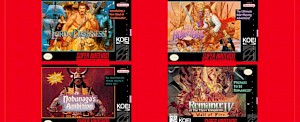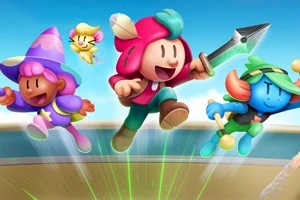Feature: Nibris - The Full Interview

Posted 12 May 2009 at 18:16 by Tom Phillips

We talk to ex-Nibris staff for the real truth about Sadness' long development, its planned storyline, and the chances of it being shown at this year's E3...
Last week we posted the first morsels of an ongoing discussion with Adam Artur Antolski, an ex-Nibris employee we tracked down who was a script-writer on Sadness, after the Polish company stated they will allegedly be showing it at this year's E3. Why has the title never seen the light of day despite three years of development? What is the game really about? And is Nibris even a real Wii developer? Read on for the truth...
- N-Europe: Hi there Adam!
Antolski: Hello. My name is Adam Artur Antolski, and I used to work for NIBRiS as a scriptwriter for the Sadness project. I'm the author of many of Sadness's characteristics that NIBRiS is still using, such as the black and white theme, time and place, major characters, and Slavic mythology references.
N-Europe: When did you start working at NIBRiS, and how long did you work there?
Antolski: I started at the very beginning, in 2006, and it lasted just over a year ... I had absolutely no experience: In fact, I wasn't even an adult yet. [I was chosen] probably because of my work as a journalist for a Nintendo website [a fansite - nothing to do with Nintendo themselves - ed.] I was very grateful back then, but I have no clue why he didn't asked someone more experienced. It is strange, but I wasn't the only one - I remember he involved a couple of others from that site, at least one of them still works for the project.
We felt it was time to delve into what was really going on at Nibris, in the year after the first trailer hit at E3 2006.
- N-E: So how many people were actually involved with Nibris then, including yourself?
Antolski: Not more than ten, I do not precisely remember, because I didn't know the entire crew.
N-E: What work did you actually do in your time there - was there any progress with actual development, or was Sadness still in pre-production?
Antolski: When [I was] contacted, there was only a title - Sadness. In about three of four days I come up with some ideas, which evolved into a "script". We actually wanted to make a interactive movie, and there was couple of other ideas as well.
When I was leaving, there was only one 3D object - some minecart I believe, which says a lot for me, most of the time the Sadness project was science-fiction.
N-E: In the space of a year then, and despite that trailer for the title, the only phase of actual development completed was a 3D minecart?
Antolski: For the actual game - I can't really recall that we'd made something else - but we had worked hard on concept design, and script and stuff like that. Despite the fact we disagreed a lot, for example about Alexander, son of the main heroine. I was against including him into a game - I believed that most gamers wouldn't really be interested in such a mother-son dynamic, and I thought it wouldn't make the game any more challenging or deep, just more annoying. Especially as, in the early days, Alexander was a crybaby, and the gamer would be forced to taking care of his every single need, every time he was scared or frightened. It is an interesting idea when you listen to it, but not very playable - it slows action, story, and makes identification with the heroine more difficult.
It's obvious work was definitely underway on the project. But this then begged the question - why the many delays?
- N-E: Were differences among staff about the title the reason why the project has been delayed so much?
Antolski: Yes, for example, originally the game was supposed to take place in a fictionalized version of the city of Lviv [a large city in Ukraine], however, most of the scriptwriters thought that Lviv was too close to civilization, that it wasn't really an isolated place, and that logically the heroine could just jump on a train and escape. Though others, including me, thought that it was the right place for horror movie: an old city, with classical, 18th Century buildings with lots of cultures inside, and therefore lots of myths and beliefs you could use. But, we changed it and now it is set in some nondescript woods and villages in Ukraine. Which is better, because you can create whatever you want, but it doesn't have that illusion of visiting a real, existing place.
N-E: By the time you left the project, had a lot of things been finalised already?
Antolski: It is really hard to tell: most of the script was finished, and concept design for sure.
We next wanted to enquire about Nibris' relationship with outside developers, and the infamous deal with Frontline that eventually fell through...
- N-E: Were there any signs that Nibris was anywhere close to entering actual development of Sadness?
Antolski: A couple of times, first when we made a deal with Frontline, and then a couple times later - but we had a lot of problems with deadlines. In my opinion: it was because there was no main designer, just three leading creative members of the team but no actual leader. There is a Polish proverb, "When there are six cooks, there is nothing to eat," and I think it sums everything up.
N-E: Frontline Studios parted ways with Nibris citing artistic differences. What were the terms of the deal with Frontline, and how much work did Nibris and Frontline get done together?
Antolski: Practically nothing. There were some meetings which I wasn't invited to, however the practical and most important matter was we couldn't match deadlines. By the way, I believe they did that 3D object, the minecart I was talking about earlier.
N-E: In the time you were there, was any basic programming done, such as work on an engine? It seems the only thing made was that 3D minecart made by Frontline, we know that Nibris only recently licensed the Gamebryo engine.
Antolski: I do not know anything about it. But yes, it seems to be like you said.
N-E: How would you comment on the relationship between Nibris and Frontline?
Antolski: We had deadlines from them which we couldn't work and they had many, I mean really many, problems with our script, and it was just like a nightmare - not only because we couldn't discuss sensible compromise inside of our team, but because someone from the outside wanted to change a couple of things. Everyone now knows how it ended. But, I think there was more of them, than the entire Nibris team at the time! It was because of those deadlines. They just didn't take us seriously.
N-E: This may seem very blunt, but speaking honestly, do you blame them?
Antolski: No, I rather blame us, if you ask me. But I was just a scriptwriter, I might not know the whole truth.
So, with development following down a rocky path, just how was life at Nibris?
- N-E: What was the atmosphere like among the Nibris team?
Antolski: At the very beginning it was very nice and friendly, later it started to be more nervous, when so many expectations came up, which I don't think we were prepared for. Not everyone, like myself, lived in the Cracow, the place where the "headquarters" are, by the time, so people from Cracow little by little marginalized everyone else - it was hard to make a decision when you have to spend two or three hours just to get there, so I preferred to be contacted then by internet, along with a couple of others, which did not work as well.
N-E: The game and Nibris have received a lot of negative feedback from press and fans. Were you affected by this?
Antolski: The funny thing is, that I actually agreed with lots of those opinions. But no, most of the time we were not aware or didn't really care.
N-E: Did Nibris actually have official Wii development kits? Are they a licensed developer?
Antolski: Well, we certainly had Dolphin development kits, for the GameCube, and as far I know, a Wii development kit is just some kind of add-on for the Dolphin.
N-E: So Nibris are licensed GameCube developers?
Antolski: I'm certain we had Dolphin, I am not sure we had that add-on for the Wii though. I was told that we were going to be licensed by Nintendo, and we were supposed to get those kits, but they didn't tell me how the whole thing ended and when.
As the interview began to wind down, we felt we still wanted to know more about the game itself...
- N-E: Can you explain the story of the title in more detail?
Antolski: The main character, Maria Lengyel, a woman of Polish-Hungarian roots was supposed to arrive in Lviv, and the city was supposed to change in the bare moonlight into a somewhat gore-covered place. The location is isolated, so that the character cannot just leave - which we found a little hard to make sound reasonable about a city. The main heroine would see visions, which were supposed to include her memories from the past, therefore the player wouldn't be sure if she really was seeing monsters or if she was just mentally insane.
N-E: So it was a bit like Eternal Darkness in that it played with your mind whilst playing?
Antolski: I wasn't familiar with Eternal Darkness in the time, but when I played it, I've noticed many similarities.
N-E: We heard Nibris wanted to use extremely innovative gameplay, what did Nibris have in mind when they said that?
Antolski: Well, we wanted players to have absolute control over the heroine - be able to use any kind of item as a weapon, due to the lack of guns. And we wanted to make it as realistic as possible, like you could for example break a bottle and use the pieces of glass like a knife, or a chair leg like a bat. If you were going to grab some person from behind, you would "catch" him using the Nunchuck and cut his throat using the Wii Remote.
N-E: Going back to E3 2006, did Nibris personally create the "trailer" for Sadness?
Antolski: We asked a director to make one for us, but yeah, that trailer is made practically by Nibris.
N-E: Nibris have apparently stated they will be showing the title at E3, do you think this is likely, considering they promised the same about GDC last year and never showed up?
Antolski: We will see, Nibris always was better in promoting than making anything, so I'm little sceptical. But, I really wish them luck.
N-E: Well, I think we're almost at the end now, but it's an N-Europe tradition to have a random question at the end of every interview. This time it's been suggested by our forum users following a heated debate. A lot of forumers have claimed that the Nintendo 64 was Black - it was even listed as black by Nintendo of Europe. However, its official name is Charcoal Grey. It's down to you. What colour was the Nintendo 64?
Antolski: Good grief, that's the hardest question you've asked. Give me a second, I have to take a good look. Mine is grey, but it's only thanks to dust. The N64 logo on the front though is on black background, and it is contrasting with the rest of the console... So, my answer is: very dark grey!
N-E: We know that'll please at least one forumer! Thanks very much for your time, Adam, it's been a pleasure.
So, will Nibris turn up at E3 this year? Only time will tell. Many thanks though to Adam for giving us some invaluable insight into Sadness story and early development history!























